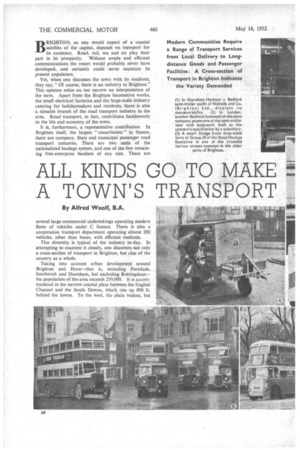Build Better Roads Now
Page 41

Page 42

Page 43

If you've noticed an error in this article please click here to report it so we can fix it.
Construction of 1,000 Miles of Motorways and Road Improvements Would Save £140m. a Year
SOME measure of the economic benefits to be derived from an improved road system in this country was given by Mr. Christopher T. Brunner in the second Rees Jeffreys Triennial lecture before the Town Planning Institute, last week. The paper, which was prepared in association with Mr. J. Drake, was entitled " The Place of a Modern Road System in the National Economy."
Estimates based on studies of the effect of road improvements abroad, he said, indicated that a minimum modernization programme involving the construction of 1,000 miles of motorways, improved traffic arteries in London and main provincial towns, and road improvements in smaller towns would produce a saving of £140m. a year. This was a conservative estimate based on road-vehicle operating expenditure in 1951.
The shelving of the 10-year plan put forward by the Ministry of Transport in 1946, said Mr. Brunner, had been a severe handicap to the proper development of Britain's post-war economy. If it had been started as planned, the nation would have already been reaping the benefit. It would have been possible at this point to look forward to the completion of a vital system of communication, to the final removal of accident. black spots and to the lowering of transport costs for industry. If Britain were to survive as a major industrial power, a revised plan should '3e put into operation without delay.
Outlining the development of road transport in this country, Mr. Brunner said that the number of goods vehicles operated in this country had almost doubled since the War. It seemed likely that the number would continue to rise for some time, but the magnitude of this expansion would be largely dependent on improvements to the road system.
So far as public service vehicles were concerned, town-planning policies aimed at the dispersal of great concentrations of population were likely to produce a call for more buses to take people to and from their work. Urban populations had become increasingly dependent on road passenger transport. The development of dormitory areas created great transport problems with unbalanced loadings, wasteful peaks and a tendency for costs and fares to rise.
Defective roads could add to the cost
of transport in the following ways:—Time was wasted because of delays,
fuel consumption was high, tyre wear was heavy and avoidable accidents were reflected in insurance costs.
Better roads did not eliminate accidents, but safety could be built into roadsThe benefitial effect of better roads on the accident rate had been proved wherever modern roads had been built.
Economic Justification
Any project for road improvement had to be judged on the• saving in operating costs it would produce. The inadequacy of the present road system was all too apparent. Urgent action was necessary to improve it. Immediate steps 'should not be considered in isolation; they should be an integral part of a long-term plan. In ,towns, there was an urgent need for the provision for off-the-street parking and for the channelling of traffic at intersections. In larger cities, it would eventually be necessary to provide elevated, sunken, or underground roads.
The transformation of the road system from its present state of inadequacy could be done only over a period of years. The economic situation must not be used as art excuse for neglecting the roads. The country's economic plight made it essential that industry should have the transport system it needed. BRIGHTON, as one would .expect of a coastal satellite of the capital, depends on transport for its existence. Road, rail, sea and air play their part in its prosperity. Without ample and efficient communications the resort would probably never have developed, and certainly could never maintain its present population.
Yet, when one discusses the town with its residents, they say, "Of course, there is no industry in Brighton." This opinion relies on too narrow an interpretation of the term. Apart from the Brighton locomotive works, the small electrical factories and the large-scale industry catering for holidaymakers and residents, there is also • a sizeable branch of the road transport industry in the area. Road transport, in fact, contributes handsomely to the life and economy of the town.
It is, furthermore, a representative contribution. In Brighton itself, the largest " conurbation " in Sussex, there are company, State and municipal passenger road transport concerns. There are two units of the nationalized haulage system, and one of the few remaining free-enterprise hauliers of any size. There are
Brighton itself is built on three shallow valleys, running north, north-east and north-west, and now extending up the southern slopes of the Downs.
Within 50 yds. of the sea-front there are steep hills. In the older parts of the town and on the Downs themselves, there are narrow roads and sharp corners. Almost the entire area is residential for, apart from the seasonal holiday population, there is a large dormitory population, living in Brighton and the associated townships, and working mainly in London.
It is against this background that transport plays its part in the life of the area. Every operator is faced with the same problems—difficult physical conditions in some parts, a large seasonal increase in demand, much movement of traffic towards London, a continual inward flow of goods and passengers, and a much smaller flow outwards, particularly of goods




















































































